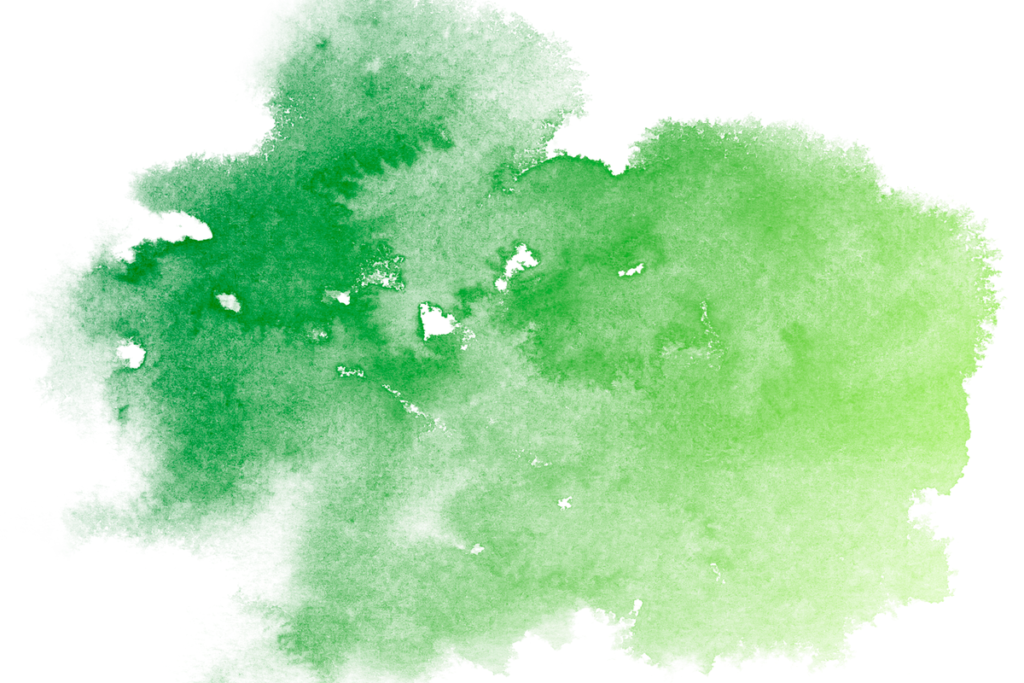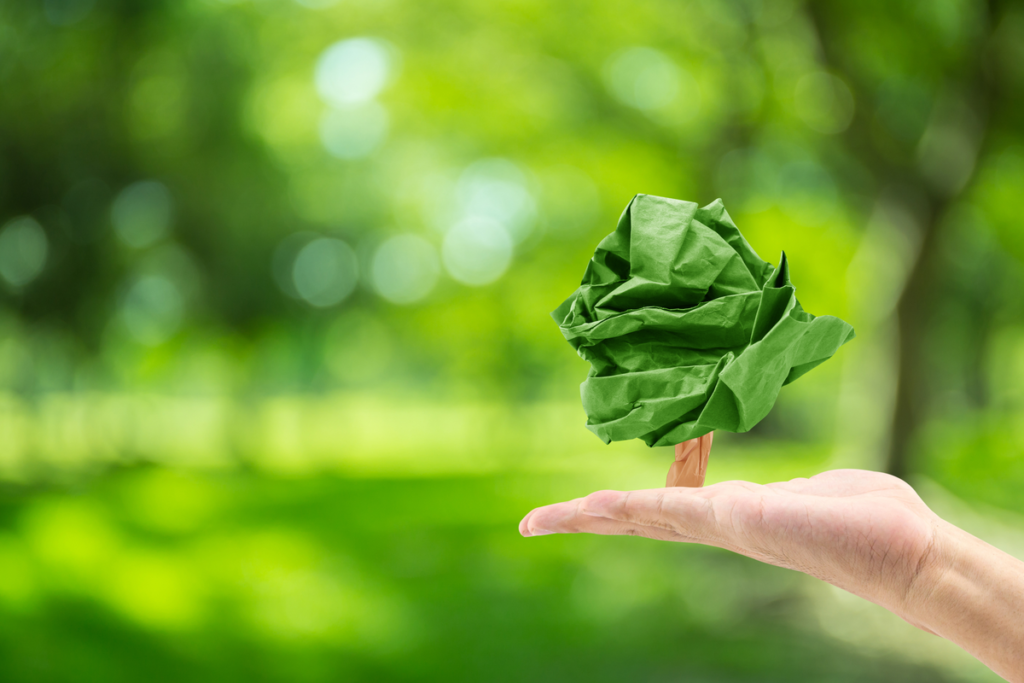What Does the Color Green Mean In Psychology?

To understand what the color green means in psychology we only need to take a look at trees, leaves, grass, and spring flowers. Indeed, we’re talking about the color scheme of both life and nature par excellence.
However, like all colors, green has different meanings in different cultures. Furthermore, it’s also often associated with negative concepts, such as toxicity or envy.
In this article, you’ll discover many facts related to this color. These range from its physical characteristics to its symbolism in human culture.
Green color characteristics
We know that color isn’t actually a property of objects. In fact, it’s a psychophysical effect of a wavelength of reflected light that the brain interprets. Depending on how far a beam of light is reflected off a surface, the brain creates a specific mental representation.
When the wavelength is within the range of 496-570 nanometers, the perceived hue corresponds to the range of green. It’s one of the primary colors of light and we have specialized cells to perceive it, along with red and blue. These cells are called cones.
When it comes to pigments, green is a secondary color. It’s obtained by mixing blue and yellow.
The most basic green is perceived at wavelengths of between 500-550 nanometers. At shorter lengths, a more bluish color is seen. However, from 550 nanometers, it tends to appear more yellowish.

The color green in psychology
Colors gain meaning and symbolism for people via individual experience and the transmission of culture. Green has often been associated mainly with life and fertility. This is due to its direct relationship with the color of vegetation.
However, there are both positive and negative meanings for this color. Here’s a summary of both.
Positive connotations of the color green
As we mentioned earlier, green is the color of life, growth, and youth. Indeed, it’s strongly associated with spring. This is the season when plants bloom and grow, and many animals reproduce. In addition, green is the quintessential color for representing hope, open-mindedness, and sensitivity.
Green is also often associated with healing and freshness, as well as good luck and joviality. Furthermore, in spiritual and mystical realms, it’s the color of serenity, calm, and emotional balance.
Negative aspects
The meaning of the color green can be related to poisonous and toxic substances, as well as radioactivity. This is a bright and powerful green, like that of some poisonous plants and animals.
In nature, bold, bright colors are indicative of danger. It acts as a method of defense against predation. This is called aposematism.
In the psychological field, we associate the color green with feelings such as immaturity and envy. For instance, we use expressions such as ‘being very green’ or ‘turning green with envy’.
Practical uses of green
The relaxing and comforting effect of green means it’s been used in places where emotional balance is necessary. For example, hospitals, schools, and meditation venues. However, in marketing, it’s used to incite action rather than relaxation.
Many environmental protection and recycling organizations use the color green. It also tends to be used in activism and solidarity campaigns. Since we tend to associate it with the natural and the healthy, it’s also common to see it used in logos and the packaging of food products.

The color green in different cultures
So far, we’ve spoken about the meaning of the color green in Western culture. However, it has different meanings in other regions of the world.
- Northern Europe. It’s associated with Christmas and the Catholic religion. It was traditionally considered a color typical of the bourgeoisie and wealthy people. That’s because it was a difficult pigment to obtain.
- Islamism: Muslims consider green to be a sacred color. They associate it with the prophet Muhammad. It’s also a symbol of strength.
- Oriental cultures. Green is related to hope, good intentions, and fertility. They often used jade to make ornamental objects and offerings.
- Ancient Egypt. They associated green with the duality of life and death. This was an aspect widely explored in the religion of this ancient civilization.
- Amazonian peoples. In the countries of South America, where the Amazon occupies a large part of the territory, they consider green to be a symbol of death. This is due to the aposematism we mentioned earlier.
All colors have their negatives and positives. As you can see, green is no different. If you’re interested in learning about how different tones influence our moods and minds, you should explore the subject in more depth. It’s an exciting field.
To understand what the color green means in psychology we only need to take a look at trees, leaves, grass, and spring flowers. Indeed, we’re talking about the color scheme of both life and nature par excellence.
However, like all colors, green has different meanings in different cultures. Furthermore, it’s also often associated with negative concepts, such as toxicity or envy.
In this article, you’ll discover many facts related to this color. These range from its physical characteristics to its symbolism in human culture.
Green color characteristics
We know that color isn’t actually a property of objects. In fact, it’s a psychophysical effect of a wavelength of reflected light that the brain interprets. Depending on how far a beam of light is reflected off a surface, the brain creates a specific mental representation.
When the wavelength is within the range of 496-570 nanometers, the perceived hue corresponds to the range of green. It’s one of the primary colors of light and we have specialized cells to perceive it, along with red and blue. These cells are called cones.
When it comes to pigments, green is a secondary color. It’s obtained by mixing blue and yellow.
The most basic green is perceived at wavelengths of between 500-550 nanometers. At shorter lengths, a more bluish color is seen. However, from 550 nanometers, it tends to appear more yellowish.

The color green in psychology
Colors gain meaning and symbolism for people via individual experience and the transmission of culture. Green has often been associated mainly with life and fertility. This is due to its direct relationship with the color of vegetation.
However, there are both positive and negative meanings for this color. Here’s a summary of both.
Positive connotations of the color green
As we mentioned earlier, green is the color of life, growth, and youth. Indeed, it’s strongly associated with spring. This is the season when plants bloom and grow, and many animals reproduce. In addition, green is the quintessential color for representing hope, open-mindedness, and sensitivity.
Green is also often associated with healing and freshness, as well as good luck and joviality. Furthermore, in spiritual and mystical realms, it’s the color of serenity, calm, and emotional balance.
Negative aspects
The meaning of the color green can be related to poisonous and toxic substances, as well as radioactivity. This is a bright and powerful green, like that of some poisonous plants and animals.
In nature, bold, bright colors are indicative of danger. It acts as a method of defense against predation. This is called aposematism.
In the psychological field, we associate the color green with feelings such as immaturity and envy. For instance, we use expressions such as ‘being very green’ or ‘turning green with envy’.
Practical uses of green
The relaxing and comforting effect of green means it’s been used in places where emotional balance is necessary. For example, hospitals, schools, and meditation venues. However, in marketing, it’s used to incite action rather than relaxation.
Many environmental protection and recycling organizations use the color green. It also tends to be used in activism and solidarity campaigns. Since we tend to associate it with the natural and the healthy, it’s also common to see it used in logos and the packaging of food products.

The color green in different cultures
So far, we’ve spoken about the meaning of the color green in Western culture. However, it has different meanings in other regions of the world.
- Northern Europe. It’s associated with Christmas and the Catholic religion. It was traditionally considered a color typical of the bourgeoisie and wealthy people. That’s because it was a difficult pigment to obtain.
- Islamism: Muslims consider green to be a sacred color. They associate it with the prophet Muhammad. It’s also a symbol of strength.
- Oriental cultures. Green is related to hope, good intentions, and fertility. They often used jade to make ornamental objects and offerings.
- Ancient Egypt. They associated green with the duality of life and death. This was an aspect widely explored in the religion of this ancient civilization.
- Amazonian peoples. In the countries of South America, where the Amazon occupies a large part of the territory, they consider green to be a symbol of death. This is due to the aposematism we mentioned earlier.
All colors have their negatives and positives. As you can see, green is no different. If you’re interested in learning about how different tones influence our moods and minds, you should explore the subject in more depth. It’s an exciting field.
All cited sources were thoroughly reviewed by our team to ensure their quality, reliability, currency, and validity. The bibliography of this article was considered reliable and of academic or scientific accuracy.
- Rivera, M. E. (2001). Percepción y significado del color en diferentes grupos sociales. Inv. Univ. Mult, 3, 74-83.
- Segura Gordillo, N. (2016). Marketing del color. ¿Cómo influye el color del logotipo en la personalidad de una marca?.
- Heller, E. (2004). Psicología del color (0 ed.). Editorial Gustavo Gili.
- Pol, E., & Robson, C. (1993). Environmental psychology in Europe: From architectural psychology to green psychology. Aldershot: Avebury.
This text is provided for informational purposes only and does not replace consultation with a professional. If in doubt, consult your specialist.







